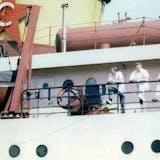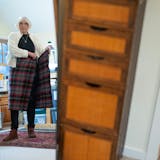The aptly named Type/Variant house is ever-changing.
Built in 1994, the copper siding-clad home was shiny and brown. As it aged, the copper oxidized, giving the panels their own patina, some a blue-green, others a deep brown.
Client Richard Polsky and Minneapolis architect Vincent James drew inspiration from rural industrial structures in Wisconsin and Minnesota, envisioning each cubic part of the home as simple, elegant timber-like features.
“We selected copper siding after seeing one of [Polsky’s] artworks — a beautiful copper etching composing a set of plates of simple variations,” James said in an email. “They loved the evolving copper color as it weathered and that the changes were outside of their control.”
The home, which won the American Institute of Architects Honor Award for Architecture in 1998 as well as the American Institute of Architects Minnesota Honor Award in 1996, even garnered a New York Times feature for its ingenuity and modernist look. After decades of enjoying all that the seven-bedroom, nine-bathroom home has to offer — from its artistic forms to fishing on the nearby lake and tapping maple trees on the property — the Polsky family recently listed the Hayward, Wis., home for $4 million and hope to find buyers who will relish it the same.
“[Us kids have] spread out quite a bit over the years. It was a place for my parents to go every summer. It was getting harder for them to get there,” said Polsky’s son Charlie Polsky. “It’s sad that the house is for sale. But it’s a house that needs to be used.”
[Sign up: Peek inside eye-catching homes, plus get tips on sprucing up your own place, with our Floored newsletter.]
Combined design
Richard Polsky always had grander ideas for his land in Hayward, about a 2½-hour drive northeast of the Twin Cities. A professor at Columbia University, he interviewed artists and was interested in how they expressed their views creatively.


